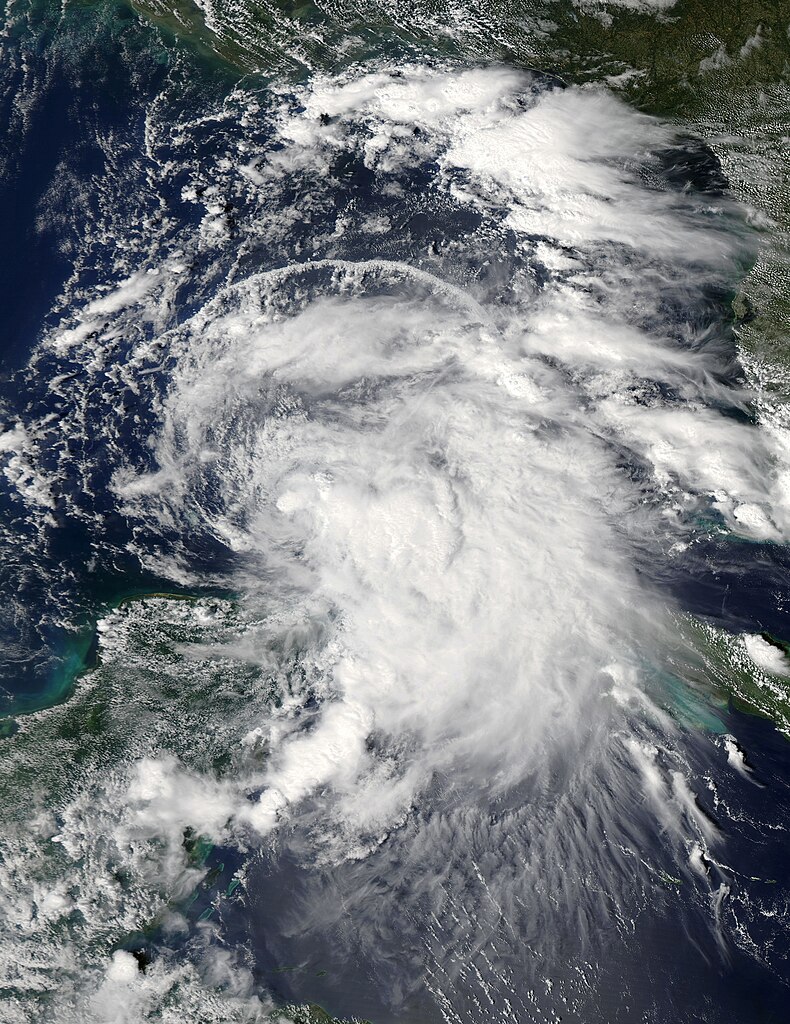Storm Active: October 21-24
On October 20, a low pressure center formed along a trough over the central Atlantic ocean and thunderstorms began to concentrate about it. By the next day, a surface circulation was developing, and the system was designated Tropical Depression Thirteen that evening. The cyclone was already moving northeastward at the time of formation, and continued to move out into the open waters of the Atlantic.
Overnight and into the morning of October 22, Thirteen became more organized as convection continued to increase in the relatively friendly atmospheric environment. Soon, the cyclone had developed a symmetric dense overcast, and thus strengthened into Tropical Storm Lorenzo. The storm's organization increased further that morning, bringing Lorenzo to its peak intensity of 50 mph winds and a pressure of 1003 mb. By this time, the system was moving toward the east, having navigated around the upper edge of a mid-level ridge.
Lorenzo maintained its intensity until October 23, when shear increased substantially out of the northwest and decoupled the surface and mid-level circulations of the system and displaced convection from the cyclone's eastern side. Before long, all thunderstorm activity had been obliterated by the blast of wind shear, and Lorenzo was downgraded to a tropical depression that night. During the morning of October 24, the system degenerated into a remnant low. The low dissipated a few days later.
The above image shows Lorenzo near its peak intensity.
Lorenzo was a short-lived tropical storm, and did not affect land.
Tuesday, October 22, 2013
Friday, October 4, 2013
Tropical Storm Karen (2013)
Storm Active: October 3-6
On September 28, a tropical disturbance formed in the southern Caribbean sea, and began to track slowly northwestward. Over the next couple of days, the trough associated with the disturbance became much better defined, but the convection associated with the system remained disorganized. Convection increased markedly around the deepening low pressure center during the days of October 1 and 2 as the system approached the Gulf of Mexico, but aircraft investigation did not discover a well-defined center of circulation. The system caused very heavy rainfall and gusty winds in eastern Cuba as it passed by, and on October 3, as the system entered the southeastern Gulf of Mexico, a defined center appeared. The system was upgraded to Tropical Storm Karen. Due to the exceptionally high winds found east of the center, the initial intensity of the cyclone was already 60 mph!
Though by the measured wind speeds, Karen was a strong tropical storm, it did not appear as such. Strong upper-level winds constantly exposed the center overnight and into October 4 as the storm moved into the central Gulf. Over the next day, Karen continued to struggle north-northwestward, weakening gradually as wind shear displaced thunderstorm activity to the east of the center. By the morning of October 5, the system had become a minimal tropical storm and was approaching the Gulf Coast.
Later that day, Karen paused again, becoming nearly stationary south of the Louisiana coastline due to a ridge situated to its east. Atmospheric conditions continued to worsen that evening, and it became evident that the cyclone's circulation was slowly deteriorating. It was downgraded to a tropical depression overnight, and dissipated early on September 6, never having made landfall. Some of the moisture associated with Karen moved northward along a frontal boundary over the next day and caused enhanced rainfall up and down the east coast.
Even at peak intensity, when the cyclone was producing 65 mph winds, Karen did not exhibit much convective organization.
Probably due to its shallow circulation, Karen's forward motion diminished as it entered the northern Gulf of Mexico and the system was ripped apart by wind shear.
On September 28, a tropical disturbance formed in the southern Caribbean sea, and began to track slowly northwestward. Over the next couple of days, the trough associated with the disturbance became much better defined, but the convection associated with the system remained disorganized. Convection increased markedly around the deepening low pressure center during the days of October 1 and 2 as the system approached the Gulf of Mexico, but aircraft investigation did not discover a well-defined center of circulation. The system caused very heavy rainfall and gusty winds in eastern Cuba as it passed by, and on October 3, as the system entered the southeastern Gulf of Mexico, a defined center appeared. The system was upgraded to Tropical Storm Karen. Due to the exceptionally high winds found east of the center, the initial intensity of the cyclone was already 60 mph!
Though by the measured wind speeds, Karen was a strong tropical storm, it did not appear as such. Strong upper-level winds constantly exposed the center overnight and into October 4 as the storm moved into the central Gulf. Over the next day, Karen continued to struggle north-northwestward, weakening gradually as wind shear displaced thunderstorm activity to the east of the center. By the morning of October 5, the system had become a minimal tropical storm and was approaching the Gulf Coast.
Later that day, Karen paused again, becoming nearly stationary south of the Louisiana coastline due to a ridge situated to its east. Atmospheric conditions continued to worsen that evening, and it became evident that the cyclone's circulation was slowly deteriorating. It was downgraded to a tropical depression overnight, and dissipated early on September 6, never having made landfall. Some of the moisture associated with Karen moved northward along a frontal boundary over the next day and caused enhanced rainfall up and down the east coast.
Even at peak intensity, when the cyclone was producing 65 mph winds, Karen did not exhibit much convective organization.
Probably due to its shallow circulation, Karen's forward motion diminished as it entered the northern Gulf of Mexico and the system was ripped apart by wind shear.
Labels:
2013 Storms
Subscribe to:
Comments (Atom)



